Development and Validation of a Reproducible and Label-Free Surface Plasmon Resonance Immunosensor for Enrofloxacin Detection in Animal-Derived Foods
Abstract
:1. Introduction
2. Materials and Methods
2.1. Reagents and Materials
2.2. Instrumentation
2.3. Synthesis of ENRO-OVA Conjugate and Anti-ENRO Ab Preparation
2.3.1. ENRO-OVA Conjugate
2.3.2. Anti-ENRO Ab
2.4. Immobilization of ENRO-OVA Conjugate on the SPR Chip Surface
2.5. Measurement Procedure of ENRO Residue
2.6. Samples Pretreatment and Spiked Method
3. Results and Discussion
3.1. Synthesis of ENRO-OVA Conjugate
3.2. Immbolization of the ENRO-OVA Conjugate on the Sensor Chip
3.3. Optimization of Anti-ENRO Ab Concentration
3.4. Anti-ENRO Ab Dissociation for SPR Chip Regeneration
3.5. Measuring Procedure for ENRO and Cross-reactivity
3.6. Sample Matrix Effect and Recovery Studies
4. Conclusions
Supplementary Materials
Acknowledgments
Author Contributions
Conflicts of Interest
References
- Hooper, D.C.; Wolfson, J.S. Quinolones Antimicrobial Agents, 2nd ed.; American Society for Microbiology: Washington, DC, USA, 1993; pp. 299–327. [Google Scholar]
- Chopra, S.; Torres-Ortiz, M.; Hokama, L.; Madrid, P.; Tanga, M.; Mortelmans, K.; Kodukula, K.; Galande, A.K. Repurposing FDA-approved drugs to combat drug-resistant Acinetobacter baumannii. J. Antimicrob. Chemoth. 2010, 65, 2598–2601. [Google Scholar] [CrossRef] [PubMed]
- Xie, S.; Yang, F.; Tao, Y.; Chen, D.; Qu, W.; Huang, L.; Liu, Z.; Pan, Y.; Yuan, Z. Enhanced intracellular delivery and antibacterial efficacy of enrofloxacin-loaded docosanoic acid solid lipid nanoparticles against intracellular Salmonella. Sci. Rep. 2017, 7, 1–9. [Google Scholar] [CrossRef] [PubMed]
- Chen, Y.; Sun, J.; Liao, X.; Shao, Y.; Li, L.; Fang, L.; Liu, Y. Impact of enrofloxacin and florfenicol therapy on the spread of OqxAB gene and intestinal microbiota in chickens. Vet. Microbiol. 2016, 192, 1–9. [Google Scholar] [CrossRef] [PubMed]
- Bonassa, K.; Miragliotta, M.; Simas, R.; Monteiro, D.; Eberlin, M.; Anadón, A.; Reyes, F. Tissue depletion study of enrofloxacin and its metabolite ciprofloxacin in broiler chickens after oral administration of a new veterinary pharmaceutical formulation containing enrofloxacin. Food Chem. Toxicol. 2017, 105, 8–13. [Google Scholar] [CrossRef] [PubMed]
- de Assis, D.C.S.; da Silva, G.R.; Lanza, I.P.; dos Santos Ribeiro, A.C.; Lana, A.M.Q.; Lara, L.J.C.; de Figueiredo, T.C.; de Vasconcelos, S. Evaluation of the presence and levels of enrofloxacin, ciprofloxacin, sulfaquinoxaline and oxytetracycline in broiler chickens after drug administration. PLoS ONE 2016, 11, e0166402. [Google Scholar] [CrossRef] [PubMed]
- Ruennarong, N.; Wongpanit, K.; Sakulthaew, C.; Giorgi, M.; Kumagai, S.; Poapolathep, A.; Poapolathep, S. Dispositions of enrofloxacin and its major metabolite ciprofloxacin in Thai swamp buffaloes. J. Vet. Med. Sci. 2016, 78, 397–403. [Google Scholar] [CrossRef] [PubMed]
- Lin, Z.; Vahl, C.I.; Riviere, J.E. Human food safety implications of variation in food animal drug metabolism. Sci. Rep. 2016, 6, 27907. [Google Scholar] [CrossRef] [PubMed]
- Wang, D.; Li, S.; Lu, T. Rule of accumulation of enrofloxacin in Acipenser baerii and drug-induced damage to the tissues. Exp. Biol. Med. 2016, 241, 1977–1984. [Google Scholar] [CrossRef] [PubMed]
- Heppell, S.; Sauer, F. The European Agency for the Evaluation of Medicinal Products; Third General Report; Springer: Berlin/Heidelberg, Germany, 1997. [Google Scholar]
- Hrvaic, B.; Kelneric, Z.; Sakar, D. Residues of enrofloxacin in chickens after oral treatment. J. Vet. Pharmacol. Ther. 1997, 20, 316. [Google Scholar]
- Okerman, L.; Van, H.J.; Debeuckelaere, W. Evaluation of the European four–plate test as a tool for screening antibiotic residues in meat samples from retail outlets. J. AOAC Int. 1998, 81, 51–56. [Google Scholar] [PubMed]
- Terrado-Campos, D.; Tayeb-Cherif, K.; Peris-Vicente, J.; Carda-Broch, S.; Esteve-Romero, J. Determination of oxolinic acid, danofloxacin, ciprofloxacin, and enrofloxacin in porcine and bovine meat by micellar liquid chromatography with fluorescence detection. Food Chem. 2017, 221, 1277–1284. [Google Scholar] [CrossRef] [PubMed]
- Tang, Y.; Li, M.; Gao, X.; Liu, X.; Ma, Y.; Li, Y.; Xu, Y.; Li, J. Preconcentration of the antibiotic enrofloxacin using a hollow molecularly imprinted polymer, and its quantitation by HPLC. Microchim. Acta 2016, 183, 589–596. [Google Scholar] [CrossRef]
- Wang, Y.; Yang, Y.; Niu, R.; Zhu, X.; Qiang, M.; Niu, G.; Wang, Y. Development and application of an immunoaffinity column clean-up for enrofloxacin determination in food samples. Food Agric. Immunol. 2017, 28, 248–259. [Google Scholar] [CrossRef]
- Tufa, R.; Pinacho, D.; Pascual, N.; Granados, M.; Companyo, R.; Marco, M. Development and validation of an enzyme linked immunosorbent assay for fluoroquinolones in animal feeds. Food Control. 2015, 57, 195–201. [Google Scholar] [CrossRef]
- Wang, J.; Pan, M.; Fang, G.; Wang, S. Preparation of a novel molecularly imprinted polymer by a sol-gel process for on-line solid-phase extraction coupled with high performance liquid chromatography to detect trace enrofloxacin in fish and chicken samples. Microchim. Acta 2009, 166, 295–302. [Google Scholar] [CrossRef]
- Speltini, A.; Sturini, M.; Maraschi, F.; Mandelli, E.; Vadivel, D.; Dondi, D.; Profumo, A. Preparation of silica-supported carbon by Kraft lignin pyrolysis, and its use in solid-phase extraction of fluoroquinolones from environmental waters. Microchim. Acta 2016, 183, 2241–2249. [Google Scholar] [CrossRef]
- Janusch, F.; Scherz, G.; Mohring, S.A.; Hamscher, G. Determination of fluoroquinolones in chicken feces—A new liquid-liquid extraction method combined with LC-MS/MS. Environ. Toxicol. Pharmacol. 2014, 38, 792–799. [Google Scholar] [CrossRef] [PubMed]
- Zhu, K.; Li, J.; Wang, Z.; Jiang, H.; Beier, R.C.; Xu, F.; Shen, J.; Ding, S. Simultaneous detection of multiple chemical residues in milk using broad-specificity antibodies in a hybrid immunosorbent assay. Biosens. Bioelectron. 2011, 26, 2716–2719. [Google Scholar] [CrossRef] [PubMed]
- Guo, L.; Xu, S.; Ma, X.; Qiu, B.; Lin, Z.; Chen, G. Dual-color plasmonic enzyme-linked immunosorbent assay based on enzyme-mediated etching of Au nanoparticles. Sci. Rep. 2016, 6, 32755. [Google Scholar] [CrossRef] [PubMed]
- Wu, Y.; Guo, S.; Dong, Q.; Song, Y. Development of an immunochromatographic test strip for rapid simultaneous detection of enrofloxacin and ofloxacin in tissue of chicken muscle and pork. Food Anal. Methods 2016, 9, 2807–2813. [Google Scholar] [CrossRef]
- Chen, J.; Xu, F.; Jiang, H.; Hou, Y.; Rao, Q.; Guo, P.; Ding, S. A novel quantum dot-based fluoroimmunoassay method for detection of enrofloxacin residue in chicken muscle tissue. Food Chem. 2009, 113, 1197–1201. [Google Scholar] [CrossRef]
- Kuang, H.; Zhao, Y.; Ma, W.; Xu, L.; Wang, L.; Xu, L. Recent developments in analytical applications of quantum dots. Trac-Trend Anal. Chem. 2011, 30, 1620–1636. [Google Scholar] [CrossRef]
- Kavanagh, O.; Elliott, C.T.; Campbell, K. Progress in the development of immunoanalytical methods incorporating recombinant antibodies to small molecular weight biotoxins. Anal. Bioanal. Chem. 2015, 407, 2749–2770. [Google Scholar] [CrossRef] [PubMed]
- Hempen, C.; Karst, U. Labeling strategies for bioassays. Anal. Bioanal. Chem. 2006, 384, 572–583. [Google Scholar] [CrossRef] [PubMed]
- Karlsson, R. SPR for molecular interaction analysis: A review of emerging application areas. J. Mol. Recognit. 2004, 17, 151–161. [Google Scholar] [CrossRef] [PubMed]
- Yang, X.; Lu, Y.; Liu, B.; Yao, J. Analysis of graphene-based photonic crystal fiber sensor using birefringence and surface plasmon resonance. Plasmonics 2017, 12, 489–496. [Google Scholar] [CrossRef]
- Homola, J. ChemInform abstract: Surface plasmon resonance sensors for detection of chemical and biological species. Chem. Rev. 2008, 39, 462–493. [Google Scholar] [CrossRef] [PubMed]
- Homola, J. Present and future of surface plasmon resonance biosensors. Anal. Bioanal. Chem. 2003, 377, 528–539. [Google Scholar] [CrossRef] [PubMed]
- Olaru, A.; Bala, C.; Jaffrezic-Renault, N.; Aboul-Enein, H.Y. Surface plasmon resonance (SPR) biosensors in pharmaceutical analysis. Crit. Rev. Anal. Chem. 2015, 45, 97–105. [Google Scholar] [CrossRef] [PubMed]
- Psarouli, A.; Botsialas, A.; Salapatas, A.; Stefanitsis, G.; Nikita, D.; Jobst, G.; Chaniotakis, N.; Goustouridis, D.; Makarona, E.; Petrou, P.S.; et al. Fast label-free detection of C-reactive protein using broad-band Mach-Zehnder interferometers integrated on silicon chips. Talanta 2017, 165, 458–465. [Google Scholar] [CrossRef] [PubMed]
- Yuan, P.; Deng, S.; Yao, C.; Wan, Y.; Cosnier, S.; Shan, D. Polymerization amplified SPR-DNA assay on noncovalently functionalized graphene. Biosens. Bioelectron. 2017, 89, 319–325. [Google Scholar] [CrossRef] [PubMed]
- Zhao, S.S.; Bukar, N.; Toulouse, J.L.; Pelechacz, D.; Robitaille, R.; Pelletier, J.N.; Masson, J.F. Miniature multi-channel SPR instrument for methotrexate monitoring in clinical samples. Biosens. Bioelectron. 2015, 64, 664–670. [Google Scholar] [CrossRef] [PubMed]
- Kamat, V.; Rafique, A. Exploring sensitivity & throughput of a parallel flow SPRi biosensor for characterization of antibody-antigen interaction. Anal. Biochem. 2017, 525, 8–22. [Google Scholar] [CrossRef] [PubMed]
- Xia, Y.; Su, R.; Huang, R.; Ding, L.; Wang, L.; Qi, W.; He, Z. Design of elution strategy for simultaneous detection of chloramphenicol and gentamicin in complex samples using surface plasmon resonance. Biosens. Bioelectron. 2017, 92, 266–272. [Google Scholar] [CrossRef] [PubMed]
- Hassani, S.; Momtaz, S.; Vakhshiteh, F.; Maghsoudi, A.S.; Ganjali, M.R.; Norouzi, P.; Abdollahi, M. Biosensors and their applications in detection of organophosphorus pesticides in the environment. Arch. Toxicol. 2017, 91, 109–130. [Google Scholar] [CrossRef] [PubMed]
- Sahoo, P.R.; Swain, P.; Nayak, S.M.; Bag, S.; Mishra, S.R. Surface plasmon resonance based biosensor: A new platform for rapid diagnosis of livestock diseases. Vet. World. 2016, 9, 1338–1342. [Google Scholar] [CrossRef] [PubMed]
- Gendloff, E.H.; Casale, W.L.; Ram, B.P.; Tai, J.H.; Pestka, J.J.; Hart, L.P. Hapten-protein conjugates prepared by the mixed anhydride method. Cross-reactive antibodies in heterologous antisera. J. Immunol. Methods. 1986, 92, 15–20. [Google Scholar] [CrossRef]
- Pan, M.; Wang, X.; Wang, J.; Lu, Y.; Qian, K.; Wang, S. Stable and sensitive detection of sulfonamide residues in animal-derived foods using a reproducible surface plasmon resonance immunosensor. Food Anal. Methods 2017, 10, 2027–2035. [Google Scholar] [CrossRef]
- Xu, Y.; Du, Y.; Li, Q.; Wang, X.; Pan, Y.; Zhang, H.; Wu, T.; Hu, H. Ultrasensitive detection of enrofloxacin in chicken muscles by surface-enhanced raman spectroscopy using amino-modified glycidyl methacrylate-ethylene dimethacrylate (GMA-EDMA) powdered porous material. Food Anal. Methods 2014, 7, 1219–1228. [Google Scholar] [CrossRef]
- Ha, M.S.; Chung, M.S.; Bae, D.H. Simple detection of residual enrofloxacin in meat products using microparticles and biochips. Food Addit. Contam. A 2016, 33, 817–823. [Google Scholar] [CrossRef] [PubMed]
- Zhao, Y.; Zhang, G.; Liu, Q.; Teng, M.; Yang, J.; Wang, J. Development of a lateral flow colloidal gold immunoassay strip for the rapid detection of enrofloxacin residues. J. Agric. Food Chem. 2008, 56, 12138–12142. [Google Scholar] [CrossRef] [PubMed]
- Wu, C.C.; Lin, C.H.; Wang, W.S. Development of an enrofloxacin immunosensor based on label-free electrochemical impedance spectroscopy. Talanta 2009, 79, 62–67. [Google Scholar] [CrossRef] [PubMed]
- Khor, S.M.; Liu, G.Z.; Peterson, J.R.; Iyengar, S.G.; Gooding, J.J. An electrochemical immunobiosensor for direct detection of veterinary drug residues in undiluted complex matrices. Electroanalysis 2011, 23, 1797–1804. [Google Scholar] [CrossRef]
- Fernández, F.; Pinacho, D.G.; Sánchez-Baeza, F.; Marco, M.P. Portable surface plasmon resonance immunosensor for the detection of fluoroquinolone antibiotic residues in milk. J. Agric. Food Chem. 2011, 59, 5036–5043. [Google Scholar] [CrossRef] [PubMed]
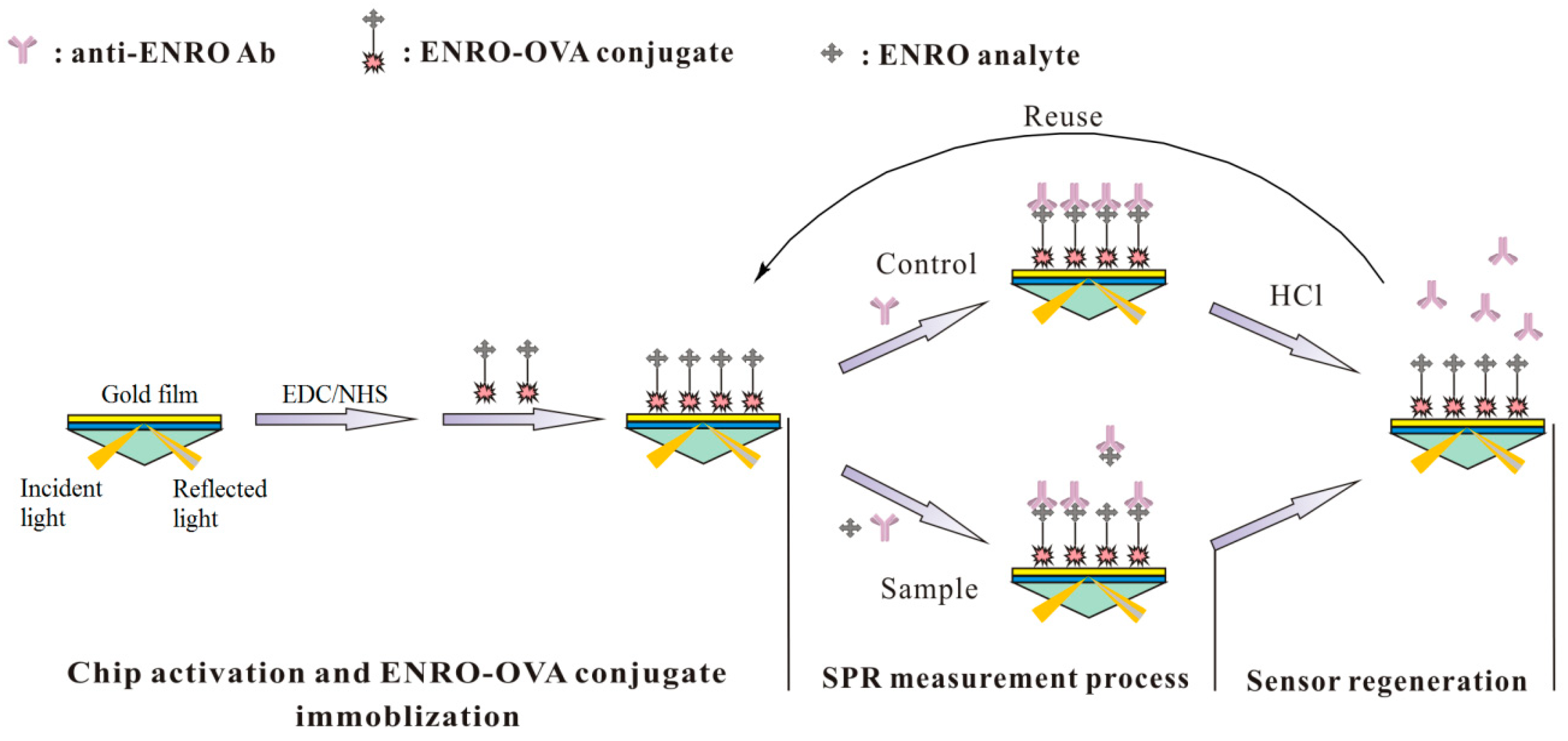

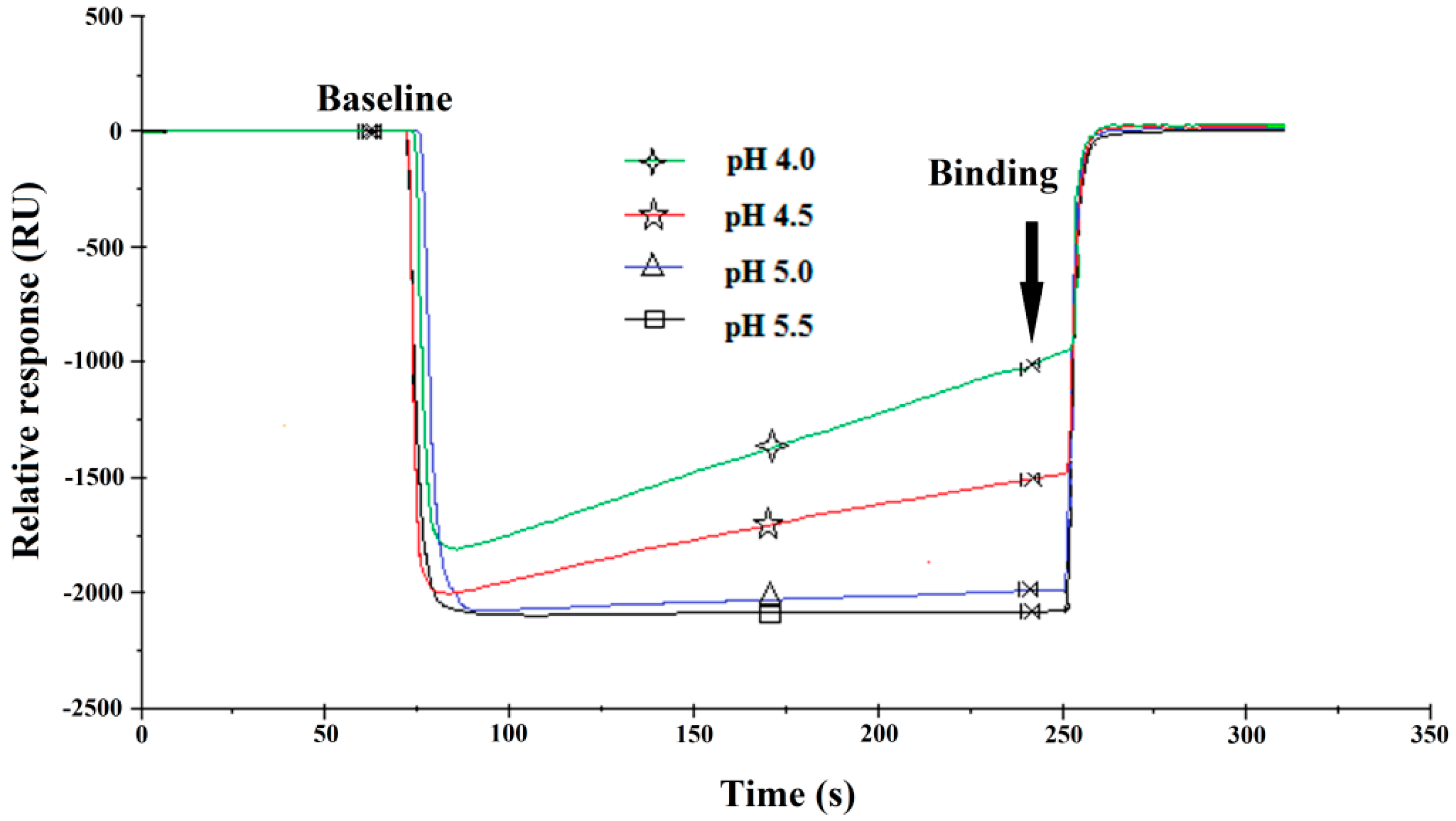
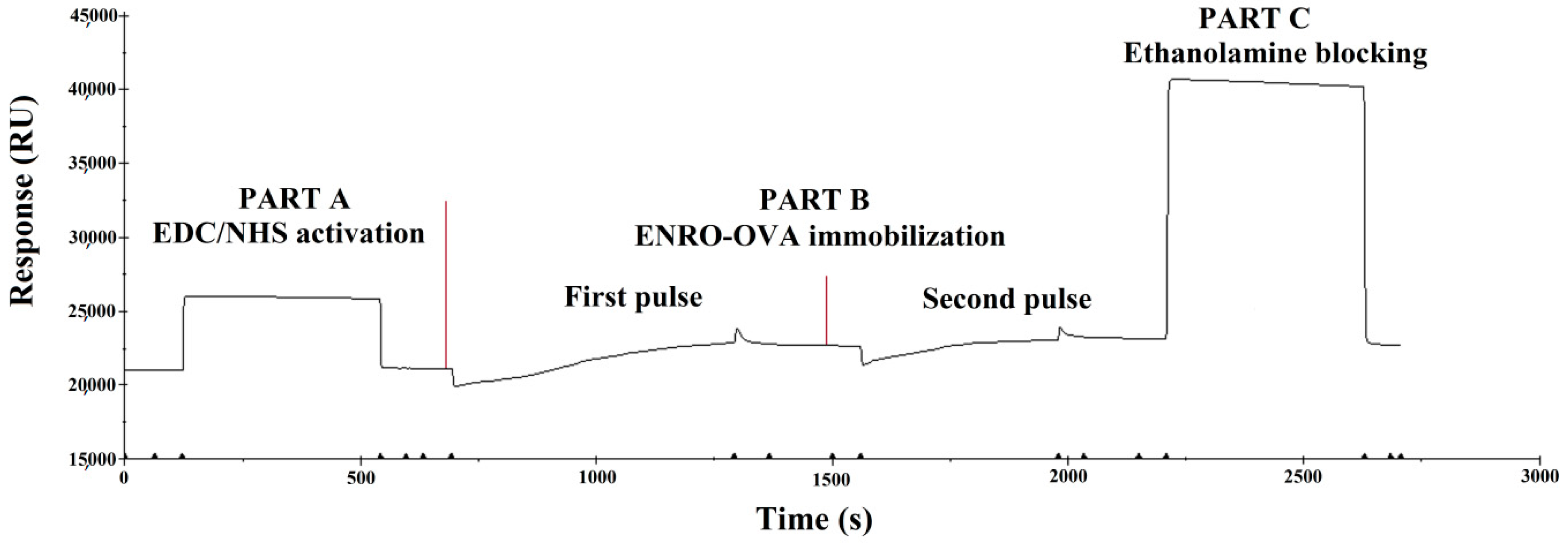
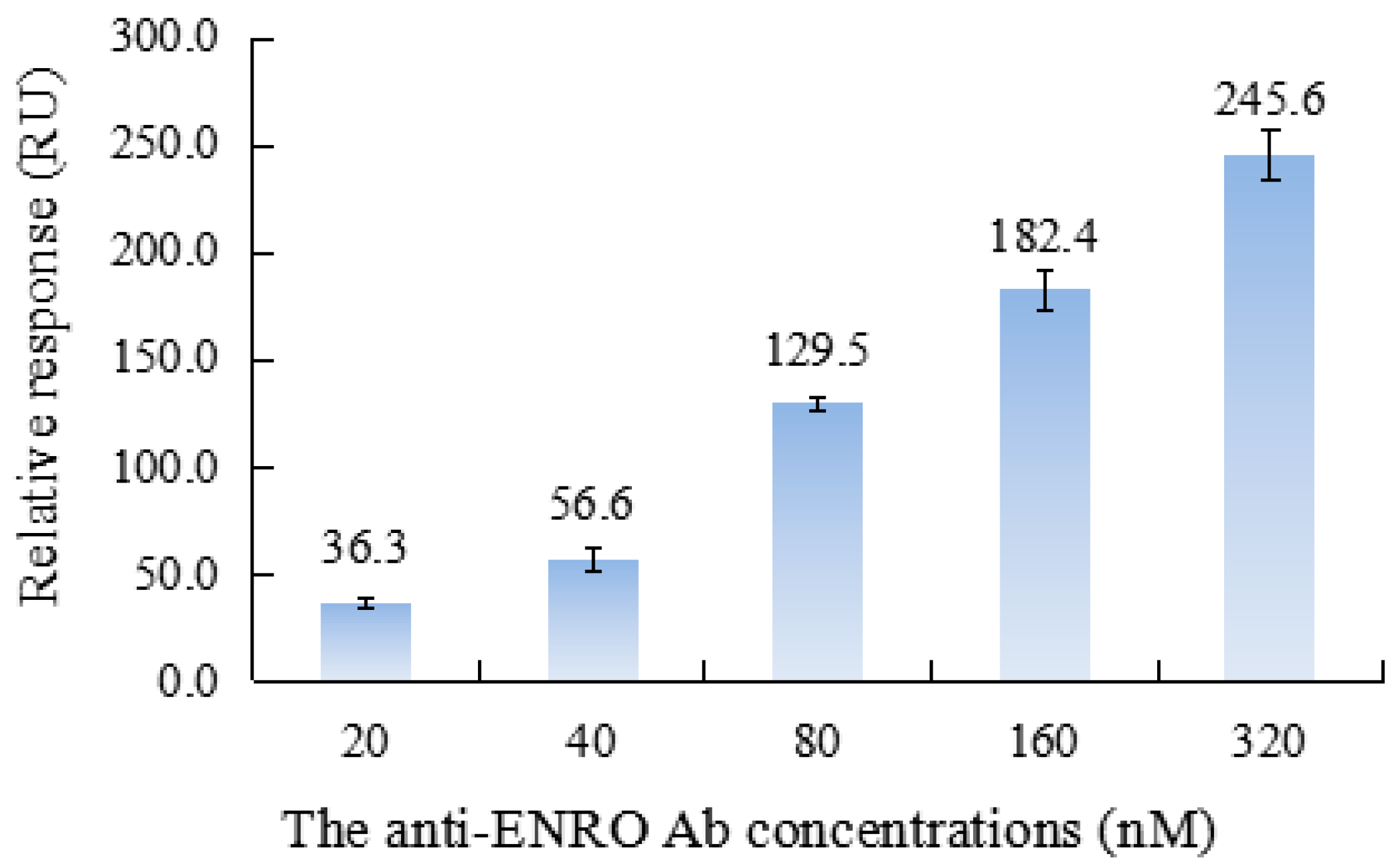

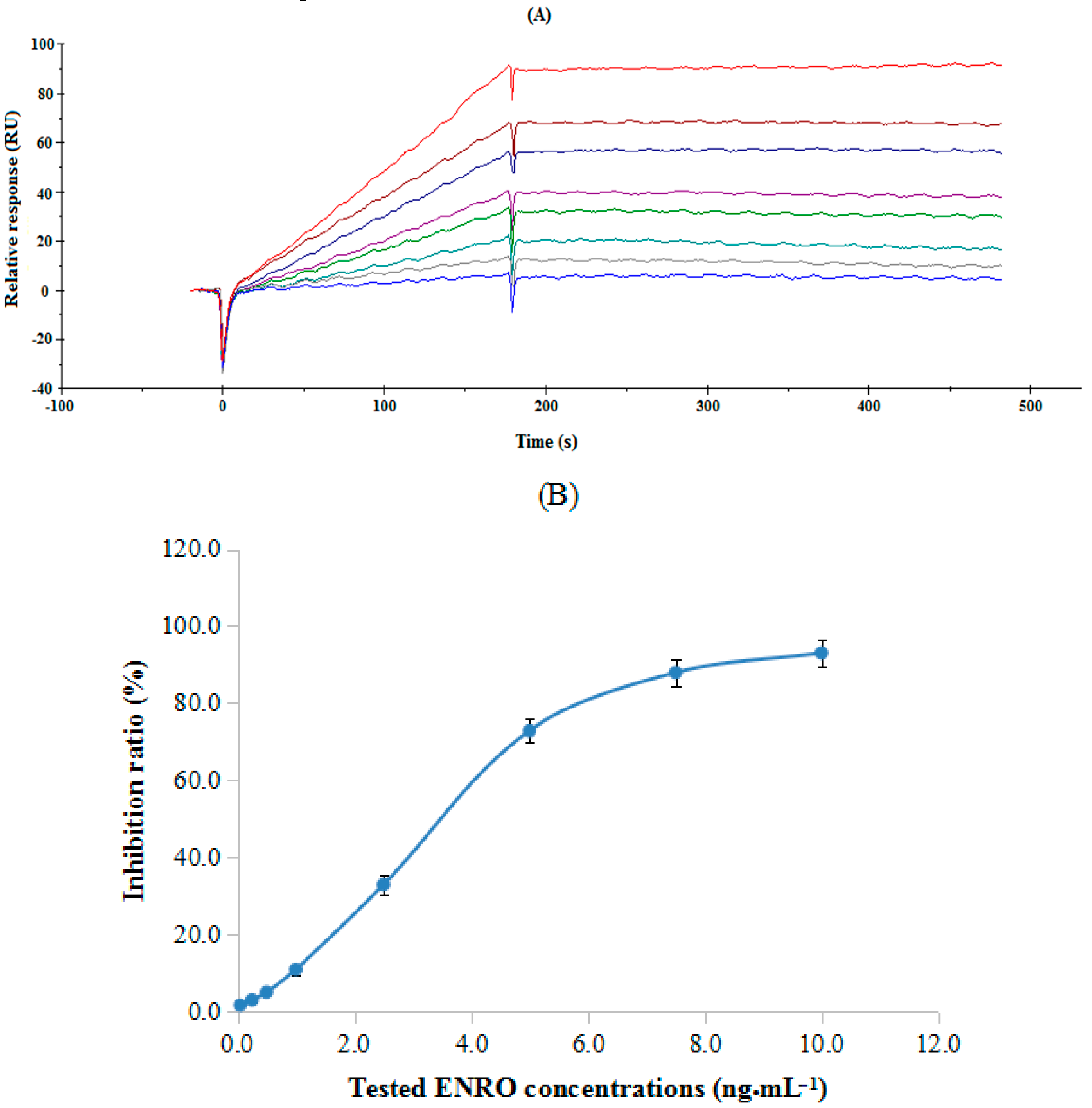
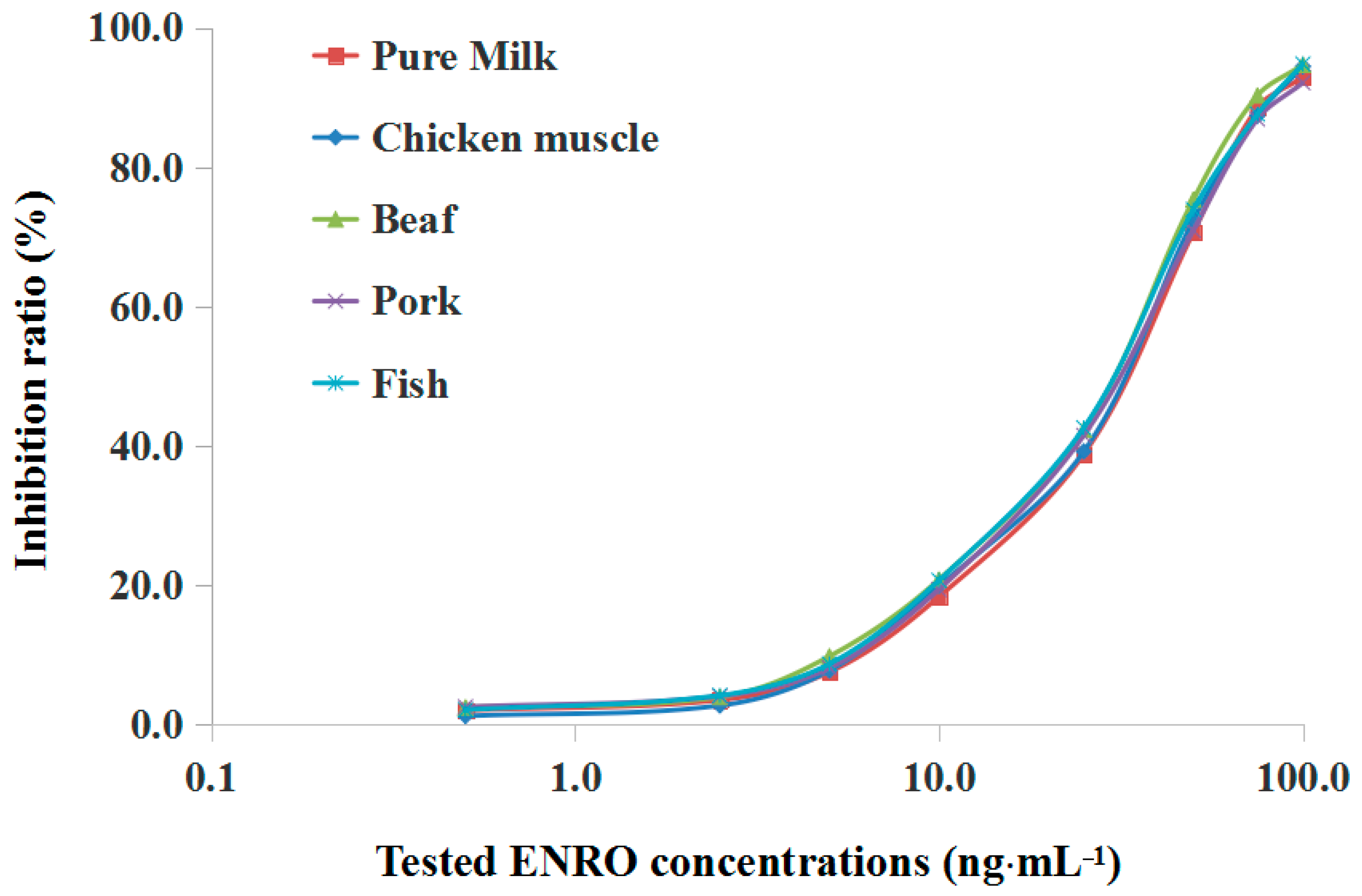
| Sample | Spiked Levels (ng·mL−1 or ng·g−1) | SPR Immunosensor | Commercial ELISA Kit | ||
|---|---|---|---|---|---|
| Recovery (%) | RSD (%, n = 5) | Recovery (%) | RSD (%, n = 3) | ||
| Pure milk | 10.0 | 88.7 | 3.0 | 113.7 | 8.7 |
| 25.0 | 92.4 | 2.5 | 90.1 | 6.1 | |
| 50.0 | 96.3 | 3.9 | 118.8 | 10.1 | |
| Chicken muscle | 10.0 | 84.3 | 1.8 | 80.3 | 2.3 |
| 25.0 | 91.2 | 2.8 | 88.8 | 4.1 | |
| 50.0 | 92.7 | 4.6 | 78.1 | 4.4 | |
| Beef | 10.0 | 87.8 | 3.8 | 89.3 | 2.8 |
| 25.0 | 93.3 | 4.5 | 104.6 | 5.2 | |
| 50.0 | 95.6 | 2.8 | 91.3 | 5.5 | |
| Pork | 10.0 | 92.5 | 3.9 | 103.9 | 8.8 |
| 25.0 | 95.3 | 3.6 | 96.8 | 5.9 | |
| 50.0 | 96.2 | 2.6 | 90.9 | 5.2 | |
| Fish | 10.0 | 89.3 | 3.3 | 101.7 | 2.3 |
| 25.0 | 94.6 | 3.9 | 88.7 | 5.1 | |
| 50.0 | 96.6 | 3.6 | 100.2 | 6.8 | |
| Methods | Sensitivity | LOD | Required Time | Reuse Cycles | Samples | References |
|---|---|---|---|---|---|---|
| Direct ELISA | 20.0 ng·g−1 | 1.3 ng·g−1 | >4.5 h | Once | feed | [15] |
| Quantum dot-based fluoroimmunoassay | 1–100 ng·mL−1 | 2.5 ng·mL−1 | >30 min | Once | Chicken muscle | [23] |
| Surface-enhanced Raman spectroscopy | - | 10 ng·mL−1 | 40 min | Once | Chicken muscle | [41] |
| Microarray analyses | - | 5 ng·kg−1 | >1 h | - | Beef, pork and chicken | [42] |
| Immunoassay strip | 0.038–22.75 ng·mL−1 | 0.935 ng·mL−1 (by scanner and eye) | 5 min | Once | Chicken muscle | [43] |
| Impedimetric immunosensors | 1–1000 ng·mL−1 | 1.0 ng·mL−1 | - | - | Blood | [44] |
| Electrochemiscal immunobiosensor | 0.01–10 ng·mL−1 | 10 pg·mL−1 | 10–15 min | - | Milk, stream water | [45] |
| Portable SPR sensor | 26.4 ± 7.2 μg·L−1 | 2.0 ± 0.2 μg·L−1 | <30 min | Once | Milk | [46] |
| SPR immunosensor | 3.8 ng·mL−1 | 1.2 ng·mL−1 | About 6 min | At least 100 times | Pure milk, egg, chicken muscle, beef and fish | This research |
© 2017 by the authors. Licensee MDPI, Basel, Switzerland. This article is an open access article distributed under the terms and conditions of the Creative Commons Attribution (CC BY) license (http://creativecommons.org/licenses/by/4.0/).
Share and Cite
Pan, M.; Li, S.; Wang, J.; Sheng, W.; Wang, S. Development and Validation of a Reproducible and Label-Free Surface Plasmon Resonance Immunosensor for Enrofloxacin Detection in Animal-Derived Foods. Sensors 2017, 17, 1984. https://doi.org/10.3390/s17091984
Pan M, Li S, Wang J, Sheng W, Wang S. Development and Validation of a Reproducible and Label-Free Surface Plasmon Resonance Immunosensor for Enrofloxacin Detection in Animal-Derived Foods. Sensors. 2017; 17(9):1984. https://doi.org/10.3390/s17091984
Chicago/Turabian StylePan, Mingfei, Shijie Li, Junping Wang, Wei Sheng, and Shuo Wang. 2017. "Development and Validation of a Reproducible and Label-Free Surface Plasmon Resonance Immunosensor for Enrofloxacin Detection in Animal-Derived Foods" Sensors 17, no. 9: 1984. https://doi.org/10.3390/s17091984
APA StylePan, M., Li, S., Wang, J., Sheng, W., & Wang, S. (2017). Development and Validation of a Reproducible and Label-Free Surface Plasmon Resonance Immunosensor for Enrofloxacin Detection in Animal-Derived Foods. Sensors, 17(9), 1984. https://doi.org/10.3390/s17091984





